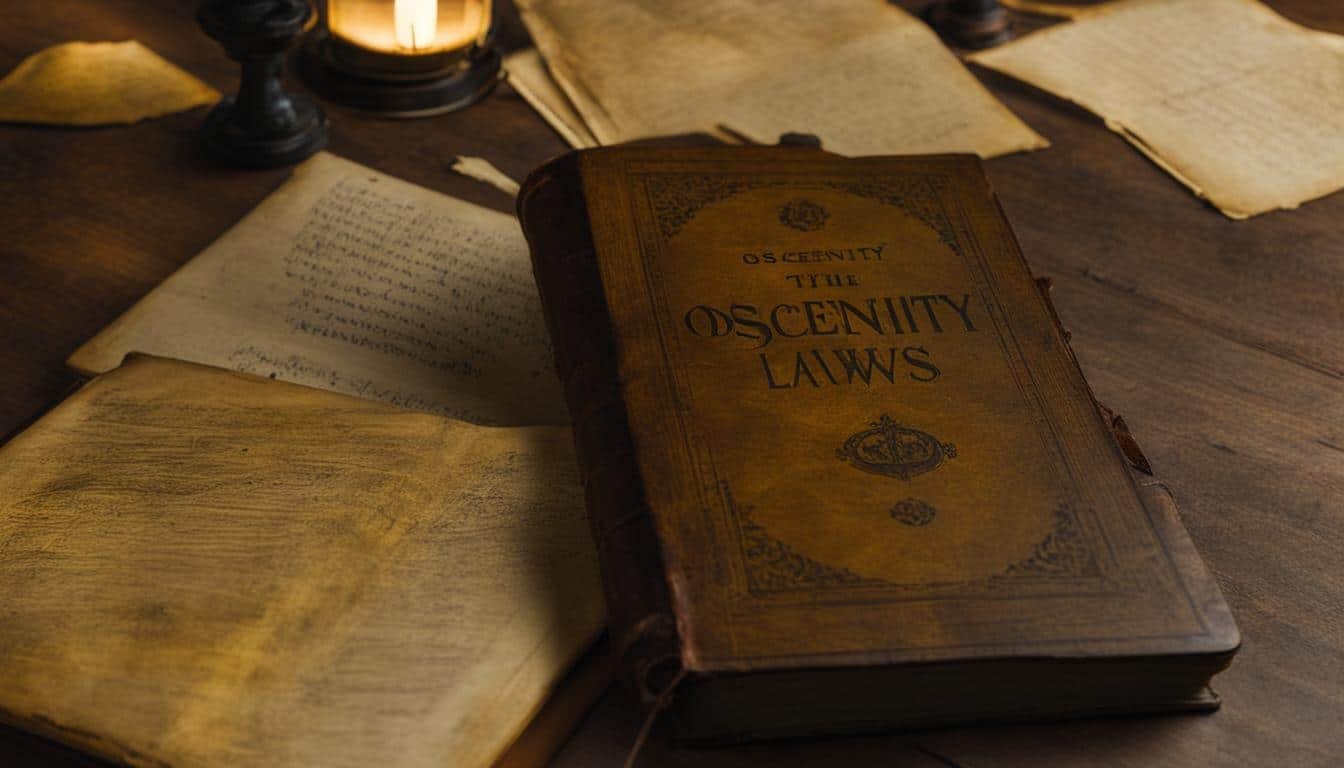When it comes to understanding the laws surrounding obscene literature, it can be a complex and confusing subject. However, having a clear understanding of these laws is crucial for both writers and readers alike. In this guide, we’ll take a closer look at the legal test for obscenity and the landmark Miller v. California decision, which set the standards for determining whether a work is considered obscene.
Key Takeaways:
- The Miller Test is the primary legal test for determining obscenity in literary works.
- It consists of three prongs: prurient interest, patently offensive depictions of sexual conduct, and lack of serious value.
- The Miller Test has faced challenges in the context of online obscenity cases.
- Applying local community standards to internet speech has been questioned for its constitutionality.
- Works with serious literary, artistic, political, or scientific value are protected by the First Amendment.
The Challenges of Applying Obscenity Laws to Online Content
When it comes to regulating obscenity in literature, the internet has presented a unique set of challenges. Online obscenity cases have raised questions about the constitutionality of applying local community standards to speech on the internet. In the landmark case of Ashcroft v. ACLU in 2002, the Supreme Court grappled with the issue of whether different communities’ standards should dictate what is considered obscene online. Justices argued that this approach could potentially infringe upon protected speech, as individuals from different communities may have diverging standards of obscenity.
The debate surrounding the application of obscenity laws to online content has intensified in recent years. The rapid growth of the internet and the borderless nature of online communication have made it increasingly difficult to determine which community’s standards should apply. Critics argue that relying on local community standards in the digital realm could result in inconsistent and unfair enforcement of obscenity laws, while proponents maintain that it is necessary to uphold community values and protect individuals from offensive content.
As technology continues to advance, the challenge of applying obscenity laws to online content persists. The evolving landscape of the internet presents novel issues that traditional legal frameworks struggle to address. The tension between protecting freedom of speech and regulating potentially harmful material remains a point of contention. This ongoing debate highlights the need for thoughtful examination and adaptation of obscenity laws to ensure their effectiveness in the digital age.
The Importance of Serious Value in Determining Obscenity
In obscenity cases, the presence or absence of serious literary, artistic, political, or scientific value plays a crucial role in determining whether a work is obscene. The Supreme Court’s decision in Miller v. California emphasized that works with such value are protected by the First Amendment and cannot be considered obscene.
However, evaluating serious value can be subjective and complex. The criteria for determining whether a work has serious value goes beyond aesthetic merit and requires an examination of the work’s contribution to matters of public concern. Was the work intended as a form of political commentary? Did it address social issues or scientific discoveries? These are the kinds of questions that courts must consider when determining the presence of serious value.
“The presence of serious value in a work is a key factor in determining its obscenity. The First Amendment protects works that contribute to public discourse and have literary, artistic, political, or scientific merit.”
It is important to note that serious value is not just about the intent of the author, but also about the impact the work has on the public. A work that encourages thoughtful discussion or provides valuable insights into important societal issues is more likely to be considered to have serious value. On the other hand, a work that simply uses offensive content as a pretext for publication without any genuine contribution to the public discourse may be deemed obscene.
Determining Serious Value in Practice
In practice, determining the presence of serious value can be a challenging task. It requires a careful examination of the content, context, and impact of the work. Courts may consider expert testimony, historical context, and the work’s reception by the public to determine whether it has serious value.
For example, a work of literature that addresses important social issues like racism or inequality and sparks meaningful conversation would likely be seen as having serious value. On the other hand, a work that simply exploits explicit sexual content for its shock value without providing any meaningful insights or commentary may be deemed obscene.
| Criteria | Examples |
|---|---|
| Literary Value | A thought-provoking novel that explores the human condition |
| Artistic Value | An avant-garde painting that challenges traditional notions of beauty |
| Political Value | A political satire that critiques government policies |
| Scientific Value | A groundbreaking scientific research paper that advances our understanding of a specific field |
Protecting Freedom of Expression
The requirement for serious value in determining obscenity is crucial in upholding the First Amendment’s protection of freedom of expression. The First Amendment recognizes the importance of allowing diverse ideas and perspectives to be expressed, even if they may be controversial or offensive to some. By considering the serious value of a work, courts strike a balance between protecting freedom of expression and preventing the dissemination of purely obscene material.
The Evolving Landscape of Obscenity Laws in Literature
State obscenity prosecutions and the challenges to existing obscenity laws continue to shape the landscape of obscenity laws in literature. While federal prosecutions have decreased, state-level cases still occur, highlighting the ongoing debates surrounding sexually explicit books and the enforcement of obscenity laws.
Legal experts have referred to this as the “myth of obsolete obscenity” as societal attitudes towards obscenity have evolved over time. The changing perspectives on what constitutes obscene material have led to the need for updated laws and guidelines.
Defining and applying obscenity laws in the context of literary works remains a complex task. The controversies surrounding these laws raise questions about freedom of expression and the balance between protecting society from potentially harmful content and preserving the rights of authors and readers.
As the cultural landscape continues to shift, it is likely that the interpretation and application of obscenity laws will remain a topic of contention and legal battles. The evolving nature of these laws underscores the importance of ongoing dialogue and examination of the principles underlying obscenity regulations.
Source Links
- https://firstamendment.mtsu.edu/article/miller-test/
- https://scholarship.law.wm.edu/cgi/viewcontent.cgi?article=2048&context=wmborj
- https://scholarship.law.duke.edu/cgi/viewcontent.cgi?article=2654&context=lcp







